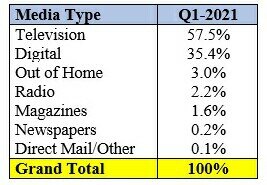The Skyrocketing Insurance Category

My friend Tim Spengler has been doing big television advertising deals for many years, having been President of Initiative, Worldwide CEO of Magna Global, President Simulmedia, President Dentsu M1, and currently General Manager, Advanced TV Solutions at Amobee, which is good news for Singtel, the company that owns Amobee. Our Zoom calls are fast-moving adventures in mind stretching ideas back and forth, looking at what's going on from our virtual space station. He piqued my interest recently by sending me this e-mail:
Hi Bill,
Did I give you my take on the most interesting category in marketing today?
1) scale (big) and growing
2) creative is key
3) data models
4) full funnel marketers
And when I yell at my friends on the media side they say, "Oh yeah, that's true"
Thought you might want to shout it, too.
Tim
So, of course we set up a Zoom to allow my brain to reach closure and, ultimately, to decide that Tim was right, and the topic deserved this article.
"Did you notice how much the insurance category is spending on advertising nowadays?" Tim asked me. I had a vague idea that it had increased since the last time I looked but was surprised when he started to rattle off the numbers.
In 2008 TRA had clocked Geico at over $400 million/year in U.S. adspend, and Allstate, Progressive and State Farm at $300-$400 million. In the second week of December 2020 (see Statista graph), Geico was spending at an annualized rate of just under $1.8 billion, more than 4x the 2008 number; Progressive at $1.5B, also 4x range vs. 2008; State Farm at $865 million, more than 2x their 2008 benchmark, and Ad Age places Allstate in 2019 at $854 million, again more than 2x where they were in 2008.
In the second week of December 2020, Geico outspent every other advertiser in the U.S., Progressive was third and State Farm eighth out of all advertisers in all categories. No other vertical had three advertisers in the top ten; auto, retail and cellular each had two advertisers in the top ten that week. (There's nothing magic or biased about that week; it was the latest Statista data posted on the internet for U.S. adspend.)
Tim had indeed noticed something that had snuck up on me, and maybe on you. I thought it was worthwhile bringing it to your attention just in case.
At TRA we had three of these insurance companies as clients. They were very math-driven companies of course; their very business depended upon actuarial probabilities. Tim also pointed this out about them. He also noticed a number of other interesting details about them:
- All the ads (except the Allstate Dennis Haysbert ads) are silly. Tim conjectures that this is perhaps to mitigate the friction filled consumer journey in that category (many complex details, could be anxiety about picking the wrong horse)
- Many different ads, as well as their humor, ameliorates the very high levels of frequency
Two hypotheses come to mind to explain why this vertical has been upping its adspend to such a degree:
- My company RMT would attribute increased adspend by insurance companies as evidence of increased demand, due probably to the security motivation being increased by world events which create insecurity (2008 market swoon, the first Black President of the U.S., the Trump presidency, rising competition from China, etc.)
- Based on the work alongside these clients at TRA, we could see that their decisions about how much to spend on advertising and how to allocate that by media was very much determined scientifically, suggesting that either it's category-driven or perhaps most advertisers are not spending enough on advertising
If there is even a possibility of the latter -- we are all underspending -- I asked Standard Media Index to share with us the last few years' ad spend trends in the insurance vertical in the U.S. and, just in case their media type shifts might be worth other types of advertisers considering, how their media allocations have been changing.
It's interesting to note that despite being a complicated consumer decision process which usually tips the scales toward digital, these insurance giants are still spending more in TV than in digital.

Interestingly, they are also spending more in broadcast than in cable network, including "tier 1 sports and other expensive programming, too" as Tim pointed out. Note in the table below how broadcast increased in 2021.
Very much countering the trend of national advertisers as regards spot television, of late they have been increasing their use of spot: +26% in the first quarter of 2021, for example, and the spot TV percentage has been increasing since 2017.

What do they know that most of us haven't figured out yet?
Click the social buttons above or below to share this content with your friends and colleagues.
The opinions and points of view expressed in this content are exclusively the views of the author and/or subject(s) and do not necessarily represent the views of MediaVillage.com/MyersBizNet, Inc. management or associated writers.


